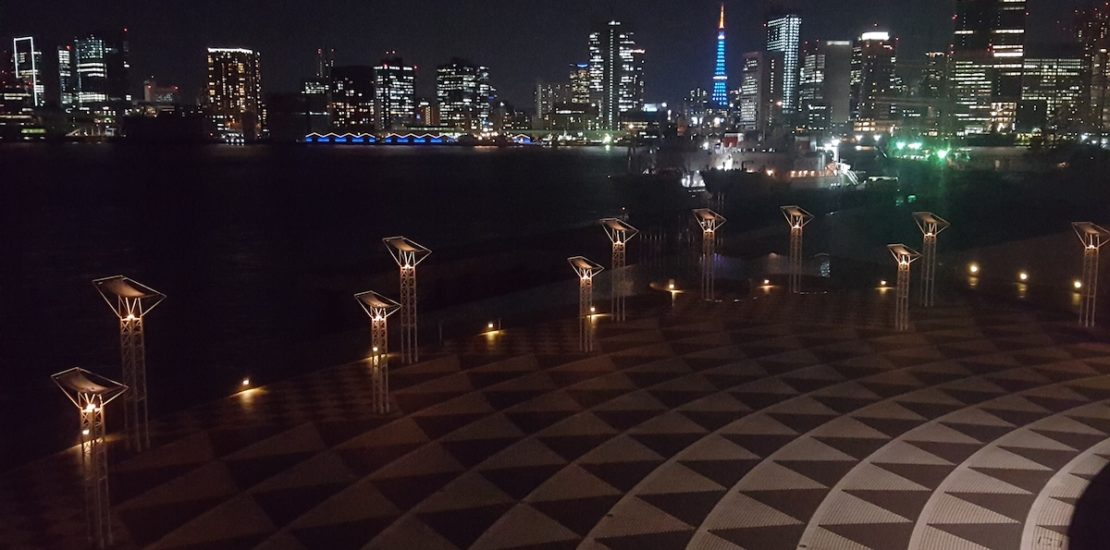
The Tokyo night views of parks, playgrounds, and cemeteries
Enjoying an outing or enduring a commute, Tokyo thoroughfares are often throttled with traffic. The hilly city hubs of Shinjuku, Shibuya and Harajuku all seem to dip low with the weight of pedestrian traffic, as sightseers and shoppers walk here and there.
These central stations are busy, and any guidebook will tell you Shinjuku is the busiest train station in the world. But if you walk up the road, out the slopes of Shibuya or towards the parks past Shinjuku, you’ll peek out of the pedestrian purview.
When you turn to look back towards the stations, the lights twinkle under the lumbering shape of the towers and shops. Just a little ways away, the central skylines of Tokyo take shape. The din dims, and the lights brighten. When night falls, the mood settles, and it all becomes picture perfect.
Grab a beer, grab a camera. You’re in Tokyo – whether you’re a backpacker or you just have the rambling itch, you only need to go a little ways. Here, you’ll find green spaces which silence the skyline and frame the best pictures of the many Tokyo night views.
Skyline of Shinjuku, Tokyo: Night Views from Mejiro-dai 1-chome Playground
Yoyogi Park has fields and trees which collect all the school-aged youth out from neighboring Harajuku. Harajuku and Shibuya offer fashion which makes Tokyo trips worth the excursion for even the poorest student.
Just a few stops north of Harajuku, the Yamanote train’s green car will take you to the verdant student neighborhoods at Mejiro station. On a hilltop bridge, the station’s small plaza overlooks the Waseda neighborhood and its large university campus.
Mejiro street is covered with small-storied campus buildings and dormitories. Propped up like an earthy book binding, the street is spotted with trees. Slopes covered in stone run down to the hidden Kanda river. Living in Mejiro’s Wakeijuku dormitory, author Haruki Murakami once drew ink and inspiration overlooking these hills and paths.
Though Murakami has moved on, magical realism still abides in Mejiro. In the night, this Mejiro magic sequesters the Shinjuku-Shibuya skyline in an unlikely place.
A couple seats and a swingset, the Mejirodai Ichi-chome playground sits between an impressive slope and an athletic park. Between all the activity and the slope’s climb, the simple playground is perfect for relaxation.
When night time brings a breather, this little place makes a picture-perfect look-out for the Tokyo night views below.

Daikanyama Tokyo Night Views: on the margin with Meguro
Hiding behind the skyscrapers of Tokyo’s central skyline is the Daikanyama neighborhood. Though it might be overshadowed by the big buildings, its affluence isn’t.
My first visit, I was invited by my international accomplices. Their shades couldn’t hide their chic tastes – the Daikanyama neighborhood consists of hillsides cascading with cafes and dotted with boutiques. Whichever restaurant we went to, we were led through clay-colored halls up to a green roof café.
Roads wrap the neighborhood much the same, like a sophisticated gift hidden beneath a Christmas tree. Among the airy openness of plazas, the greatest gift unravels in the warm scent of actual trees. It’s the delight of daimyos: a former garden of the Saigou family of samurai.
Saigouyama park appears unassuming as Daikanyama – but it is as rich as the rest of this town. It wears a crown of green, ringed by its sakura trees.
When Daikanyama dozes, Saigouyama keeps a half-opened eye on its little spot of Tokyo. Naka-meguro glimmers below, and young lovers dream sugarplum dreams on the benches below the sakura trees.

The Transportative Tokyo Night Views of Harumi Wharf
While Daikanyama has organic riches, other well-to-do neighborhoods revel in their wealth. Ginza is the seat of all things gold and glamor. Its boulevard catches a host of high-class tourism, and its streetlights draw long nights bright with dayglow.
Consumed with designer brands, the streets sleep deep after a day of excesses. When night comes in, take a bus out to Harumi. From here, Ginza and all Tokyo becomes a sleepy twinkle.
On my first walk to the south of Harumi, the Tokyo light cut out among the gunmetal high-rises. A massive construction development dead in the night, the little light around was clouded in the glasswork. Beyond it, over the waters before Tokyo bay, was the one structure that kept the light on.

The Harumi Passenger Ship Terminal is a strangely faceted structure. It greets international visitors disembarking from cruise ships during day. Past night it draws no crowds, and the wide waters of Sumida gape a space away from city congestion.
With Odaiba to the east, Sengakuji to the west, and Rainbow Bridge to the south, major landmarks glitter into view.
A dusting of Ginza gold shows in the city skyline, but the only color under the shapes of Harumi Park are in the little green park at its side. Night in the sky and seas separate the skyline from Harumi. Whichever night it is, Tokyo Tower shines its old orange in a miniature world across the river. At the mouth of Tokyo Bay, Harumi wharf feels like the edge of everything.

The Broadcast Tower of Tokyo: Night Views for Sweet Youths at Oyokogawa Shinsui Park
Even in August, only one couple sat under the Harumi Passenger Terminal. Looking out to the Tokyo skyline in all the darkness, the ember-lit color was fit for a tryst. But the chill of water and expanse of Tokyo Bay is perhaps too much for a colder or lonelier season.
Away from the bay, many couples find a cozier date in a place like Skytree. A little dining, some impressive illumination – and a Christmas market in December. Its designed for a compact date night, tinsel twinkle and desert sweets together with a few minutes of romantic stroll just outside.
Skytree offers a lot – and the 634-meter-tall tower is impressive. But to get the best impression, you have to settle into the surroundings. The 100 degree angle face of the small river at its base is one romantic recline, with seats that offer optimal Tokyo night views of the tower. However, the length of Skytree is more photogenic from an alternative angle.
A five-minute stroll across one bridge and the next, and the slim Oyokogawa Shinsui Park opens in its flowery plaza. The walkway invites you lower, onto the park’s altered riverbed arranged in a passage between the aquatic and arboreal.
Germinated in the ghost of a river, Oyokogawa Shinsui Park’s path leads below between the lights of unevenly-tiered apartments. The rise and fall of its low level and the lights impart the path with a soporific sense. Bridge after bridge, Oyokogawa has rock beds and tree beds that will turn a sleepy body this way and that.
Past the park’s densest canopy, there’s an open-skied and reed-filled pond. Wooden platforms with uncalculated alignments go over the water in uncertain ways, but one look back at Skytree will make sense of this weird wood. Oyokogawa Shinsui Park is an arboreal parallel to Skytree, and as captured at night, attracts the fullest aesthetic adoration for this new Tokyo tower.

A Tomb with a View: Cemetery Tokyo Night Views
As a pretty point of light, Skytree is a lively spot. Wherever a romantic stroll goes, whether to Oyokogawa or beyond to the love hotels of Kinshicho, its light gives love transmissions. Love buds on the Skytree.
The Ikebukuro skyline has its own icon with the Sunshine 60 building. A little electric avenue runs out from the station, where a number of youth from the nearby universities take some of their free time. The lower levels of Sunshine 60 are a mall where you’ll find children of all ages, and the upper levels have an observation space.
Additionally, it’s been observed that the Sunshine 60 is haunted. So when night falls on Sunshine 60, its glow is best appreciated from one of Tokyo’s cemeteries.
Zoshigaya Cemetery has thousands of headstones. Its grave plot is filled with authors, and among other Tokyo night views, its design sets a strange sense of romance in place. It is dark beneath the boughs, darkness which doubles past nightfall.
Whether you bike through with friends or take a private walk between the headstones, the cemetery’s center warms under the view of Sunshine 60.

At night, when everyone goes home, Sunshine 60 sits empty at the cemetery’s side. Zoshigaya may be quiet, but thousands have made it their resting place. Breathe deep and free a finger to snap a still, as the Ikebukuro skyline rests in view of your lens and Zoshigaya exposes one of its timeless moments.
The Tokyo night views for the midnight muse
Many foreign dignitaries are buried at Zoshigaya cemetery. Travelers of their time, their posthumous home has made a photogenic place for anybody who isn’t too buried in their itinerary or livelihood. These people helped build this skyline, and left an open invitation to wax aesthetic.
Tokyo is a real cache of photo opportunities, but the congestion is contagious. The secret spots for Tokyo night views can be hard to sniff out. But if you make clear for these spaces, you’ll find the skyline. All you need is a playground bench, and all Tokyo will light up your lens.
Author: Ethan Cookman



